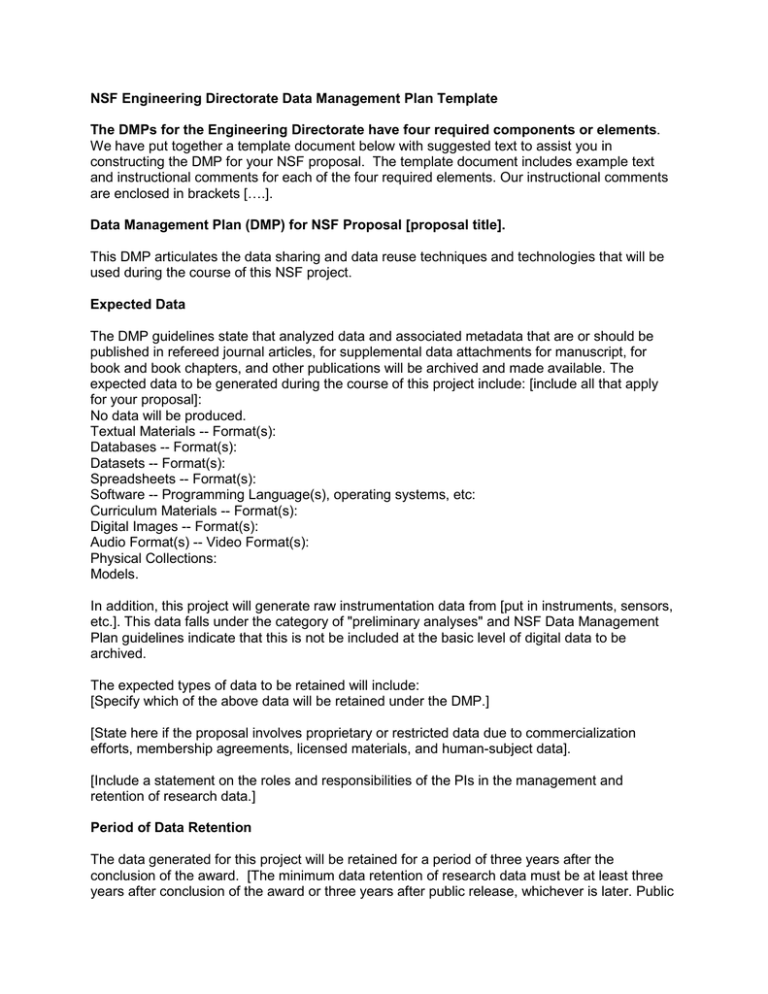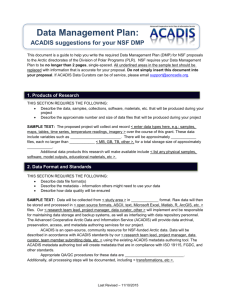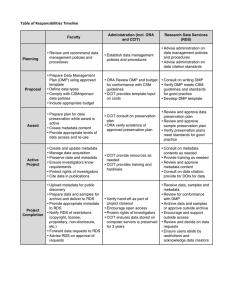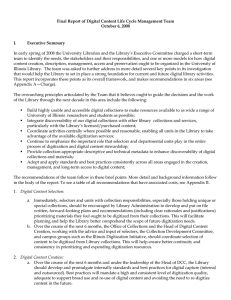NSF Engineering Directorate Data Management Plan Template
advertisement

NSF Engineering Directorate Data Management Plan Template The DMPs for the Engineering Directorate have four required components or elements. We have put together a template document below with suggested text to assist you in constructing the DMP for your NSF proposal. The template document includes example text and instructional comments for each of the four required elements. Our instructional comments are enclosed in brackets [….]. Data Management Plan (DMP) for NSF Proposal [proposal title]. This DMP articulates the data sharing and data reuse techniques and technologies that will be used during the course of this NSF project. Expected Data The DMP guidelines state that analyzed data and associated metadata that are or should be published in refereed journal articles, for supplemental data attachments for manuscript, for book and book chapters, and other publications will be archived and made available. The expected data to be generated during the course of this project include: [include all that apply for your proposal]: No data will be produced. Textual Materials -- Format(s): Databases -- Format(s): Datasets -- Format(s): Spreadsheets -- Format(s): Software -- Programming Language(s), operating systems, etc: Curriculum Materials -- Format(s): Digital Images -- Format(s): Audio Format(s) -- Video Format(s): Physical Collections: Models. In addition, this project will generate raw instrumentation data from [put in instruments, sensors, etc.]. This data falls under the category of "preliminary analyses" and NSF Data Management Plan guidelines indicate that this is not be included at the basic level of digital data to be archived. The expected types of data to be retained will include: [Specify which of the above data will be retained under the DMP.] [State here if the proposal involves proprietary or restricted data due to commercialization efforts, membership agreements, licensed materials, and human-subject data]. [Include a statement on the roles and responsibilities of the PIs in the management and retention of research data.] Period of Data Retention The data generated for this project will be retained for a period of three years after the conclusion of the award. [The minimum data retention of research data must be at least three years after conclusion of the award or three years after public release, whichever is later. Public release should be immediately after publication. Exceptions requiring longer retention may occur when data supports patents or a large collection useful to the broader community.] Data Formats and Dissemination The data generated under this project will be made available for sharing and re-use in several ways. [State here plans for storage of materials in subject disciplinary, national laboratory, departmental, college, or university sites.] In addition, the University of Illinois Library has a history of successfully supporting the preservation of and access to Illinois research outputs. The data generated under this project and information supporting preservation and reuse will be deposited in a data-sharing platform recommended by the University of Illinois’ Research Data Service (RDS) (http://researchdataservice.illinois.edu/) at the University of Illinois Library. The data curation experts in the RDS will assist in the assessment of disciplinary, institutional, and other public repositories to determine the most viable solution for the preservation of access to the data. The Library is developing a trusted digital repository environment that will be compliant with all preservation and archiving standards. Commonly generated processed data made available in publishing formats such as [State specific data types such as textual materials, curriculum materials, software, etc data.] can be deposited in the University of Illinois Library’s IDEALS (Illinois Digital Environment for Access to Learning and Scholarship) campus digital repository. IDEALS provides preservation, search, and browsing functions at http://www.ideals.illinois.edu/. IDEALS is designed to collect, disseminate, and provide persistent and reliable access to the research and scholarship of faculty, staff, and students at the University of Illinois. IDEALS provides a direct deposit mechanism for loading digital content and assigning the appropriate metadata for the content. IDEALS will provide the capability of open access self-archiving of articles. Include here if provisions for protection of privacy, confidentiality, security, intellectual property, proprietary data needing an embargo period, etc. are appropriate for your project. Also, publication delay policies, if applicable, must be clearly stated here.] Additional materials and metadata [state the types of materials] will be stored in [a specified storage location such as the CSL cluster, the Turin Cluster, MRL storage facility, NCSA, the CITES storage option, etc.]. [Omit this if all materials will be stored in a Library repository such as IDEALS]. The appropriate metadata for project data will be decided in conjunction with RDS and will be assigned in accordance with established metadata standards and best practices. The Dublin Core Metadata Initiative specification and standards (http://dublincore.org/) will be investigated and applied whenever possible. Additional discipline specific controlled vocabulary schemes will be used in the assignment of project data metadata. This will be done in consultation and collaboration with consultants in RDS and the Grainger Engineering Library Information Center (http://search.grainger.uiuc.edu/top/). Data Storage and preservation of access Storage and preservation dataset repositories are administered by the University Library and operated by NCSA and the University of Illinois Technology Services campus computing group. The University of Illinois offers a rich and comprehensive cyberinfrastructure environment and the Library provides a trusted and effective preservation and archiving environment for data and publications generated under federal funding. In addition, the Library Information Technology Group and the Grainger Engineering Library have developed custom access and discovery technologies that will be leveraged and enhanced for this grant project. [All other computing and storage resources would be described here.]




